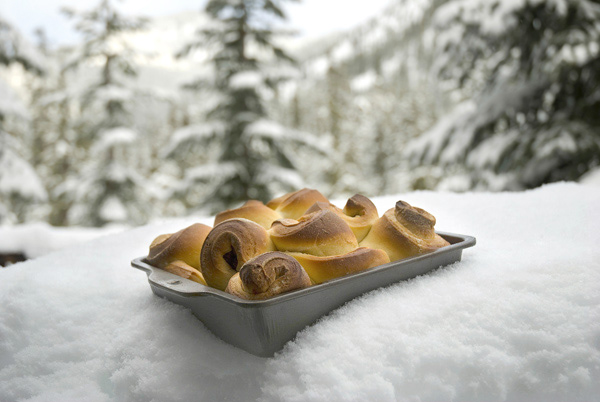
One of my favorite things to do when I'm up overnight at our little mountain cabin is to make cinnamon rolls, with a long slow rise. I get a batch of dough going, and let it sit for a long time in a cool corner, to rise all day. Before turning in for the night I roll the dough out and shape the rolls. Sometimes I make them all the same size, and sometimes I make them look like mountain peaks, the way I've done in this recipe. They're just perfect the next morning with freshly brewed cabin coffee.
Cascade Cabin Cinnamon Rolls
Makes 8 large rolls
For the dough:
½ cup water at 100º
2 teaspoons yeast
2/3 cup milk, scalded and cooled
4 Tablespoons butter
¾ cup sugar
1 teaspoons salt
4 cups all-purpose flour
¼ cup flour for benchwork
For the filling:
2 Tablespoons butter, lightly melted
¾ cups raisins (I use golden raisins)
3 teaspoons cinnamon
2 Tablespoons sugar
Make the dough: Mix the water and yeast in a 4-quart bowl and let sit for 10 minutes to foam. Scald the milk in a small saucepan and add the butter to the milk while it's cooling. Add the ¾ cup sugar, the salt and 2 cups of flour to the yeast mixture in the bowl and, when the milk has cooled to body heat add it as well. Stir with the handle of a wooden spoon for 200 beats to make a smooth batter.
Add the other 2 cups of flour and work it into the dough to incorporate. Make a ball with the dough, scraping the sides of the bowl as necessary. Turn the dough out onto a lightly floured counter and knead for 5 minutes. Clean and dry the bowl.
Long rise: Put the dough ball into the bowl, cover with a lid or a piece of plastic wrap, and let sit in a corner to rise. Optimal temperature for this rise is 55-60º. If you can't achieve this temperature you may have to improvise by putting the dough by a doorway or on a cellar step. Let sit for 8 to 10 hours, punching down if the dough is super active.
Shape the rolls: Roll the dough into a 10" x 18" rectangle. If your cabin has no rolling pin use a wine bottle, as I do. Spread 2 Tablespoons of barely melted butter over the flattened dough.
Cut the dough into equal quarters, and then cut each quarter in half lengthwise at a 20º angle so that one end of each finished piece is 3" wide and the other 2".
Mix the raisins, cinnamon and sugar in a coffee cup and spoon equal portions along the center of each dough piece. When all the raisin mixture is distributed, roll each piece up, starting with the widest end and keeping one side flat as you roll.
Overnight rise: Arrange the somewhat unwieldy rolls in a buttered 8" square metal or glass pan. They'll want to flop some, so let them. Cover loosely with plastic wrap and let rise for 7 hours at 55º.
Bake the rolls: In the morning, let the rolls sit near the morning fire for an hour to warm up some. Preheat the oven to 425º and, once hot, put in the rolls. Bake for 10 minutes, lower the oven temperature to 350º and bake for 25-30 minutes more. If the tops get too dark, drape a piece of foil over the rolls for the last 10 minutes.
When the rolls are baked, put down your snow shovel and grab some coffee. The rolls should probably cool for 30 minutes, but I really wouldn't know - I've never been able to wait that long!
Disclaimer: These results were obtained in a mountain cabin with thin insulation and a 40-year old electric stove. Rising and baking times will vary.
For complete text and a few more photos, see original content at www.woodfiredkitchen.com